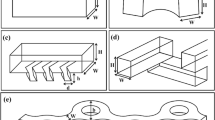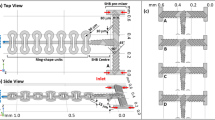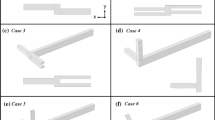Abstract
This article describes a passive micromixer that utilizes an air-liquid interface and surface tension effects to enhance fluid mixing via convection and Marangoni effects. Performance of the microfluidic component is tested within a passive-pumping-based device that consists of three microchannels connected in succession using passive micro-mixers. Mixing was quantified at 5 key points along the length of the device using microscope images of patterned streams of Alexa 488 fluorescent-dyed water and pure DI water flowing through the device. The passive micro-mixer mixed fluid 15–20 times more effectively than diffusion between laminar flow streams alone and is a novel micro-mixer embodiment that provides an additional strategy for removing external components from microscale devices for simpler, autonomous operation.
Similar content being viewed by others
References
Kakuta, M., Bessoth, F.G. & Manz, A. Microfabricated Devices for Fluid Mixing and Their Application for Chemical Synthesis. Chem. Rec. 1, 395–405 (2001).
Ottino, J.M. & Wiggins, S. Designing optimal micromixer. Science 305, 485–486 (2004).
Stone, H.A., Stroock, A.D. & Ajdari, A. Engineering flow n small devices: Microfluidics toward a lab-ona-chip. Annu. Rev. Fluid Mech. 36, 381–411 (2004).
Nguyen, N.-T. & Wu, Z. Micromicers-a review. J. Micromech. Microeng. 15, R1–R6 (2005).
Hessel, V., Lowe, H. & Schonfeld, F. Micromixers-a review on passive and active mixing principles. Chemical Eng. Sci. 60, 2479–2501 (2005).
Long, M., Sprague, M.A., Grimes, A.A., Rich, B.D. & Khine, M. A simple three-dimensional vortex micromixer. Appl. Phys. Lett. 94, 133501 (2009).
Sudarsan, A.P. & Ugaz, V.M. Multivortex micromixing. Proc. Natl. Acad. Sci. 103, 7228–7233 (2006).
Wu, Z. & Nguyen, N.-T. Convective-diffusive transport in parallel lamination micromixer. Microfluid. Nanofluid. 1, 208–217 (2005).
Sudarsan, A.P. & Ugaz, V.M. Fluid mixing in planar spiral microchannels. Lab. Chip 6, 74–82 (2006).
Park, S.J. et al. Rapid three-dimensional passive rotation micromixer using the breakup process. J. Micromech. Microeng. 14, 6–14 (2004).
Voldman, J., Gray, M.L. & Schmidt, M.A. An integrated liquid mixer/valve J. Microelectromech. Syst. 9, 295–302 (2000).
Stroock, A.D. et al. Chaotic mixer for microchannel. Science 295, 647–651 (2002).
Paik, P., Pamula, V.K. & Fair, R.B. Rapid droplet mixers for digital microfluidic systems. Lab. Chip 3, 253–259 (2003).
Paik, P., Pamula, V.K., Pollack, M.G. & Fair, R.B. Eletrowetting-based droplet mixers for microfluidic systems. Lab. Chip 3, 28–33 (2003).
Hong, C.C., Choi, J.W. & Ahn, C.H. A novel in-plane passive microfluidic mixer with modified Tesla structures. Lab. Chip 4, 109–113 (2004).
Liu, R.H. et al. Passive mixing in a three-dimensional serpentine microchannel. J. Microelectromech. Syst. 9, 190–197 (2000).
Oddy, M.H., Santiago, J.G. & Mikkelsen, J.C. Electrokinetic instability micromixing. Anal. Chem. 73, 5822–5832 (2001).
Duffy, D.C., McDonald, J.C., Schueller, O.J.A. & Whitesides, G.M. Rapid prototyping of microfluidic systems in poly(dimethylsiloxane). Anal. Chem. 70, 4974–4984 (1998).
Xia, Y.N. & Whitesides, G.M. Soft lithography. Annu. Rev. Mar. Sci. 28, 153–184 (1998).
Jo, B.H., Van Lerberghe, L.M., Motsegood, K.M. & Beebe, D.J. Three-dimensional micro-channel fabrication in polydimethylsiloxane (PDMS) elastomer. J. Microelectromech. Syst. 9, 76–81 (2000).
Ju, J., Warrick, J. & Beebe, D.J. A Cell Programmable Assay (CPA) chip. Lab. Chip 10, 2071–2076 (2010).
Hatch, A., Garcia, E. & Yager, P. Diffusion-based analysis of molecular interactions in microfluidic devices. Proc. IEEE 92, 126–139 (2004).
Author information
Authors and Affiliations
Corresponding author
Rights and permissions
About this article
Cite this article
Ju, J., Warrick, J. Passive micromixer using by convection and surface tension effects with air-liquid interface. BioChip J 7, 361–366 (2013). https://doi.org/10.1007/s13206-013-7407-1
Received:
Accepted:
Published:
Issue Date:
DOI: https://doi.org/10.1007/s13206-013-7407-1




